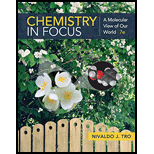
Interpretation: The given compound having the higher boiling point is to be identified.
Concept Introduction:
A hydrocarbon is organic compound consisting entirely of hydrogen and carbon.
The temperature at which the vapour pressure of the liquid is equal to the pressure exerted on the liquid by the surrounding atmosphere is called boiling point.
The boiling point of a molecule depends upon intermolecular forces and thermal energy.
Intermolecular forces keep the molecules together. Greater the intermolecular force, higher is the boiling point.
All atoms and molecules possess dispersion forces which depend upon their molar mass.
Polar molecules possess dipole forces between them which depend upon the polarity of the molecules.
A molecular formula consists of the
Dispersion forces are weak intermolecular forces and are considered van der waals forces.
Temporary dipoles can occur in non-polar molecules when the electrons that constantly orbit the nucleus occupy a similar location by chance.
Higher the molar mass, higher is the magnitude of the dispersion forces, and hence, higher is the boiling point.
Answer to Problem 12.1YT
Solution:
Explanation of Solution
The boiling point of a molecule depends upon the intermolecular forces and the thermal energy. Intermolecular forces depend upon dispersion forces and dipole forces. The molecules,
Since the molar mass of
The boiling point of
Want to see more full solutions like this?
Chapter 12 Solutions
Chemistry In Focus
- Predict which liquid—glycerol, HOCH2CH(OH)CH2OH, or hexane, C6H14—has the greater surface tension. Explain your prediction.arrow_forwardDefine the following and give an example of each: (a) dispersion force (b) dipole-dipole attraction (c) hydrogen bondarrow_forwardFor each of the following pairs, choose the member with the lower boiling point. Explain your reason in each case. (a) NaCl or PCl3 (b) NH3 or AsH3 (c) C3H7OH or C2H5OCH3 (d) HI(g) or HCl(g)arrow_forward
- On the basis of intermolecular attractions, explain the differences in the boiling points of n butane (1 C) and chloroethane (12 C), which have similar molar masses.arrow_forwardWhich would you expect to have the higher fusion enthalpy, N2 or I2? Explain your choice.arrow_forwardIn each of the following groups of substances, pick the one that has the given property. Justify your answer. a. highest boiling point: HBr, Kr, or Cl2 b. highest freezing point: H2O, NaCl, or HF c. lowest vapor pressure at 25C: Cl2, Br2, or I2 d. lowest freezing point: N2, CO, or CO2 e. lowest boiling point: CH4, CH3CH3, or CH3CH2CH3 f. highest boiling point: HF, HCl, or HBr g.arrow_forward
- A tank of gas at 21C has a pressure of 1.0 atm. Using the data in the table, answer the following questions. Explain your answers. a If the tank contains carbon tetrafluoride, CF4, is the liquid state also present? b If the tank contains butane, C4H20, is the liquid state also present?arrow_forwardChloroform, CHCl3, has a normal boiling point of 61C. Its vapor pressure at 43C is 0.526 atm. What is the concentration (in g/L) of CHCl3 when it saturates the air at 27C?arrow_forwardGases that cannot be liquefied at room temperature merely by compression are called permanent gases. How could you liquefy such a gas?arrow_forward
- 5-86 Using the phase diagram of water (Figure 5-20), describe the process by which you can sublime 1 g of ice at-10°C and at 1 atm pressure to water vapor at the same temperature.arrow_forwardDiethyl ether (CH3CH2OCH2CH3) was one of the first chemicals used as an anesthetic. At 34.6C, diethyl ether has a vapor pressure of 760. torr, and at 17.9C, it has a vapor pressure of 400. torr. What is the H of vaporization for diethyl ether?arrow_forwardUse Figure 11.7 to estimate the boiling point of diethyl ether, (C2H5)2O, under an external pressure of 470 mmHg.arrow_forward
 General Chemistry - Standalone book (MindTap Cour...ChemistryISBN:9781305580343Author:Steven D. Gammon, Ebbing, Darrell Ebbing, Steven D., Darrell; Gammon, Darrell Ebbing; Steven D. Gammon, Darrell D.; Gammon, Ebbing; Steven D. Gammon; DarrellPublisher:Cengage Learning
General Chemistry - Standalone book (MindTap Cour...ChemistryISBN:9781305580343Author:Steven D. Gammon, Ebbing, Darrell Ebbing, Steven D., Darrell; Gammon, Darrell Ebbing; Steven D. Gammon, Darrell D.; Gammon, Ebbing; Steven D. Gammon; DarrellPublisher:Cengage Learning General, Organic, and Biological ChemistryChemistryISBN:9781285853918Author:H. Stephen StokerPublisher:Cengage Learning
General, Organic, and Biological ChemistryChemistryISBN:9781285853918Author:H. Stephen StokerPublisher:Cengage Learning Chemistry: The Molecular ScienceChemistryISBN:9781285199047Author:John W. Moore, Conrad L. StanitskiPublisher:Cengage Learning
Chemistry: The Molecular ScienceChemistryISBN:9781285199047Author:John W. Moore, Conrad L. StanitskiPublisher:Cengage Learning Chemistry: Principles and ReactionsChemistryISBN:9781305079373Author:William L. Masterton, Cecile N. HurleyPublisher:Cengage Learning
Chemistry: Principles and ReactionsChemistryISBN:9781305079373Author:William L. Masterton, Cecile N. HurleyPublisher:Cengage Learning Introduction to General, Organic and BiochemistryChemistryISBN:9781285869759Author:Frederick A. Bettelheim, William H. Brown, Mary K. Campbell, Shawn O. Farrell, Omar TorresPublisher:Cengage Learning
Introduction to General, Organic and BiochemistryChemistryISBN:9781285869759Author:Frederick A. Bettelheim, William H. Brown, Mary K. Campbell, Shawn O. Farrell, Omar TorresPublisher:Cengage Learning Chemistry & Chemical ReactivityChemistryISBN:9781337399074Author:John C. Kotz, Paul M. Treichel, John Townsend, David TreichelPublisher:Cengage Learning
Chemistry & Chemical ReactivityChemistryISBN:9781337399074Author:John C. Kotz, Paul M. Treichel, John Townsend, David TreichelPublisher:Cengage Learning





